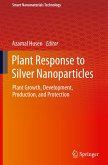Silver nanoparticles are found to have wide applications in diverse areas like optical receptors, bio-labelling sensors, bio active materials, solar energy conversion, signal enhancers in SERS based enzyme Immunoassay [1]. Silver nano particles exhibit high antimicrobial and anti cancer activities. The fabrication of silver nanoparticles and nano structures has aroused the interest of many researchers. Various synthesis methods have also been developed. Among the existing synthesis methods, mostly chemical methods, which involve toxic and potentially hazardous chemicals, are mostly used. The green synthesis based on green chemistry, replaces hazardous chemicals by environmental friendly products. Green Chemistry is the utilization of a set of principles that reduces or eliminates the use or generation of hazardous substances. Biological methods are better substitute for the chemical procedures, because they are convenient, widely distributed along the ecological boundaries and are safe to handle. The objective of the present work is to synthesize silver nanoparticles by the methods designed on the principles of green chemistry. The designed methods focus mainly on control over the size of the nanoparticles. This work also includes the study of the effect of current (through the circuit), temperature, strength of the precursor, reducing/capping agents and concentration of the capping agents on nanoparticles and the nanostructures. The as-synthesized silver nanoparticles are analyzed using various characterization techniques e.g. XRD, TEM , UV-Visible spectroscopy etc. This work finds application of the silver nanoparticles in biomedical field. The findings of the tests conducted for antibacterial properties show almost 100% killing efficiency against E. coli, S. Aureus, S. Typhi and P. Aeruginosa. In case of testing the samples for anti-cancer activities, the results show 80-98% growth inhibition for MC F-7 Breast Cancer cell lines and He-La cervical cancer cell lines. The monograph contains 5 chapters. Chapter 1 gives a brief introduction of silver nanoparticles, covering their properties, synthesis approaches and applications. Chapter 2 introduces historical background of silver and narrates exhaustive literature review conducted during the research. The chapter gives details about the existing physical, chemical and biological approaches and identifies the gap in the present synthesis methods. It justifies the need and importance of the present work. Chapter 3 gives details about the materials and the synthesis methods used in the present research work. It describes the five different methods, designed in the present research work, with varying parameters that control the morphology of the nanoparticles and nanostructures. Chapter 4 gives the results and discussions in details regarding the as-synthesized silver nanoparticles. The results are analyzed and discussed, sequentially according to the five methods. Chapter 5 provides summary and conclusion of the present research work and the scope of future work.
Hinweis: Dieser Artikel kann nur an eine deutsche Lieferadresse ausgeliefert werden.
Hinweis: Dieser Artikel kann nur an eine deutsche Lieferadresse ausgeliefert werden.








